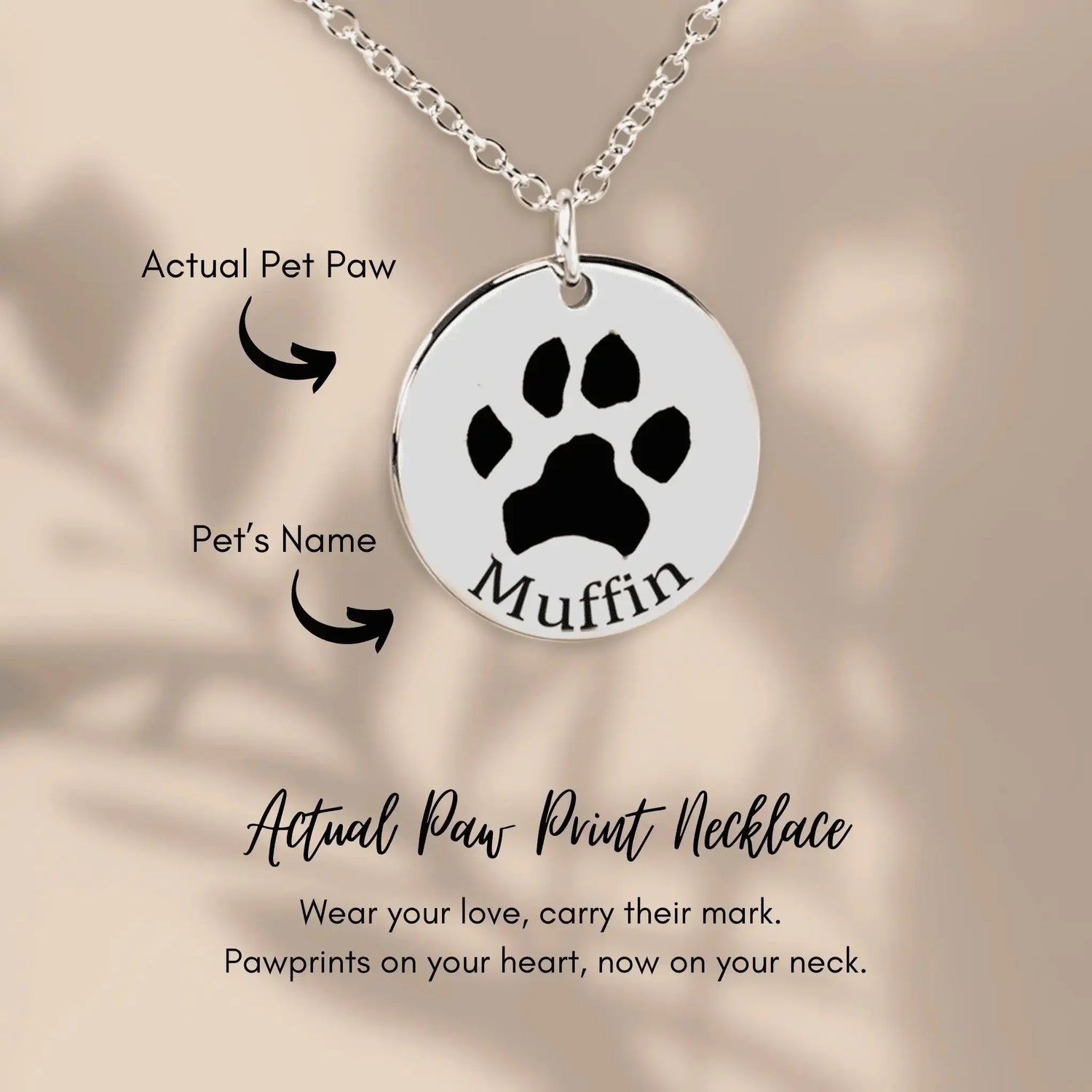Why Does My Cat Yell at Me? 😹
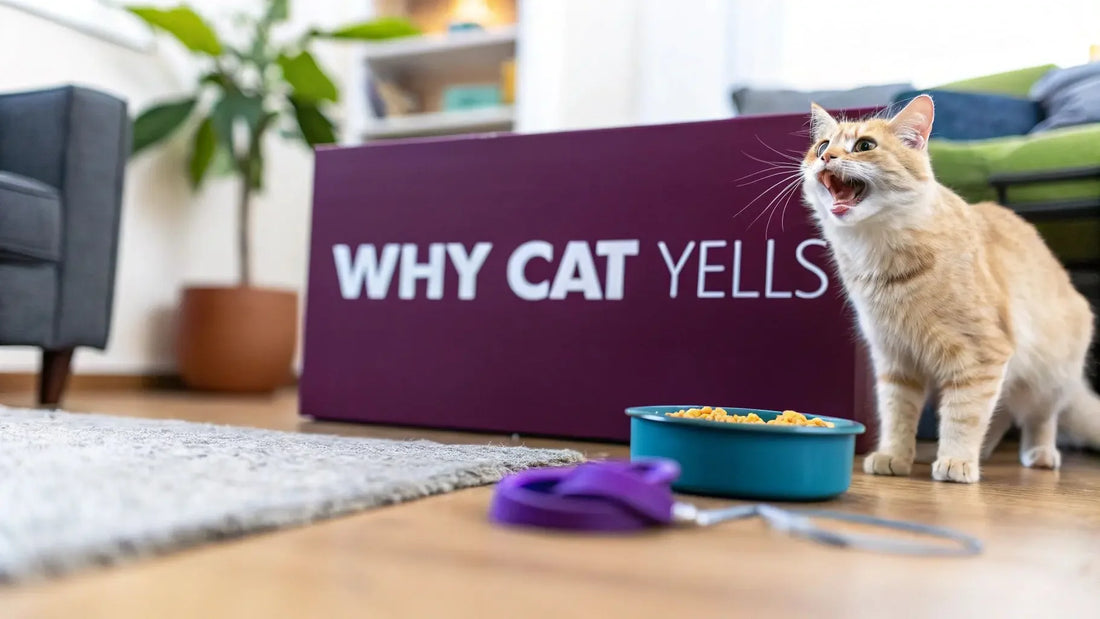
So, you’re the proud parent of a particularly chatty cat? Welcome to the club! If you’re constantly wondering, "Why does my cat yell at me?" you’re definitely not alone. The short answer is simple: your cat is trying to tell you something important.
It could be anything from a demand for a midnight snack 🍗 to a cry for attention, or even a signal that they aren't feeling their best. It's their own unique, and very direct, way of communicating with their favorite purr-son in the world.
Decoding Your Cat’s Yells A Quick Guide
Our very own mascot, Floofie, is a world-class yeller, so trust us, we get it. It can feel like you're living with a furry, four-legged alarm clock that has no snooze button. But those meows, yowls, and chirps aren't just random noise—they're actually part of a surprisingly complex language your cat has developed just for you.
Believe it or not, cats have a pretty impressive vocal range, with researchers identifying up to 21 different vocalizations. Domestic cats have especially perfected their meows to get our attention, turning their "yelling" into a highly effective tool for everything from expressing hunger to demanding cuddles. You can discover more insights about cat communication from the experts.
"Think of yourself as a feline linguist in training. Every meow has a purpose, and learning to interpret them is the key to a happier, quieter home. It's less about stopping the noise and more about understanding the message."
To help you get fluent fast, we put together a handy translation guide. Consider this your first step toward becoming a certified cat behavior detective. Before you know it, you'll be able to tell a "my food bowl is tragically empty" yowl from a "hey, you stopped petting me!" meow in a heartbeat.
Ready to crack the code? Here’s a quick look at what your little fluffball might be trying to say.
| Type of Yell | What It Sounds Like | Potential Meaning |
|---|---|---|
| Short, High-Pitched Meow | A quick, sweet "mew!" or "mrrp?" | A friendly greeting or a simple "hello!" |
| Repeated, Insistent Meows | "Meow! Meow! Meow!" often near the kitchen | "I'm hungry, human! Feed me right meow!" 😋 |
| Long, Drawn-Out Yowl | A loud, mournful "Mroooooow" | Can be a sign of distress, boredom, or a medical issue. |
| Chirps and Trills | A bird-like, rolling sound | Excitement! Usually happens when spotting a bird or a fun toy. |
Handling the Attention-Seeking Meow
Do you have a furry little diva on your hands, one who demands the spotlight at all hours? 👑 Sometimes, the simplest answer to "why does my cat yell at me" is that they just want you. This classic attention-seeking meow is one of the most common reasons for a chatty kitty, and our mascot Floofie is an absolute pro at it.
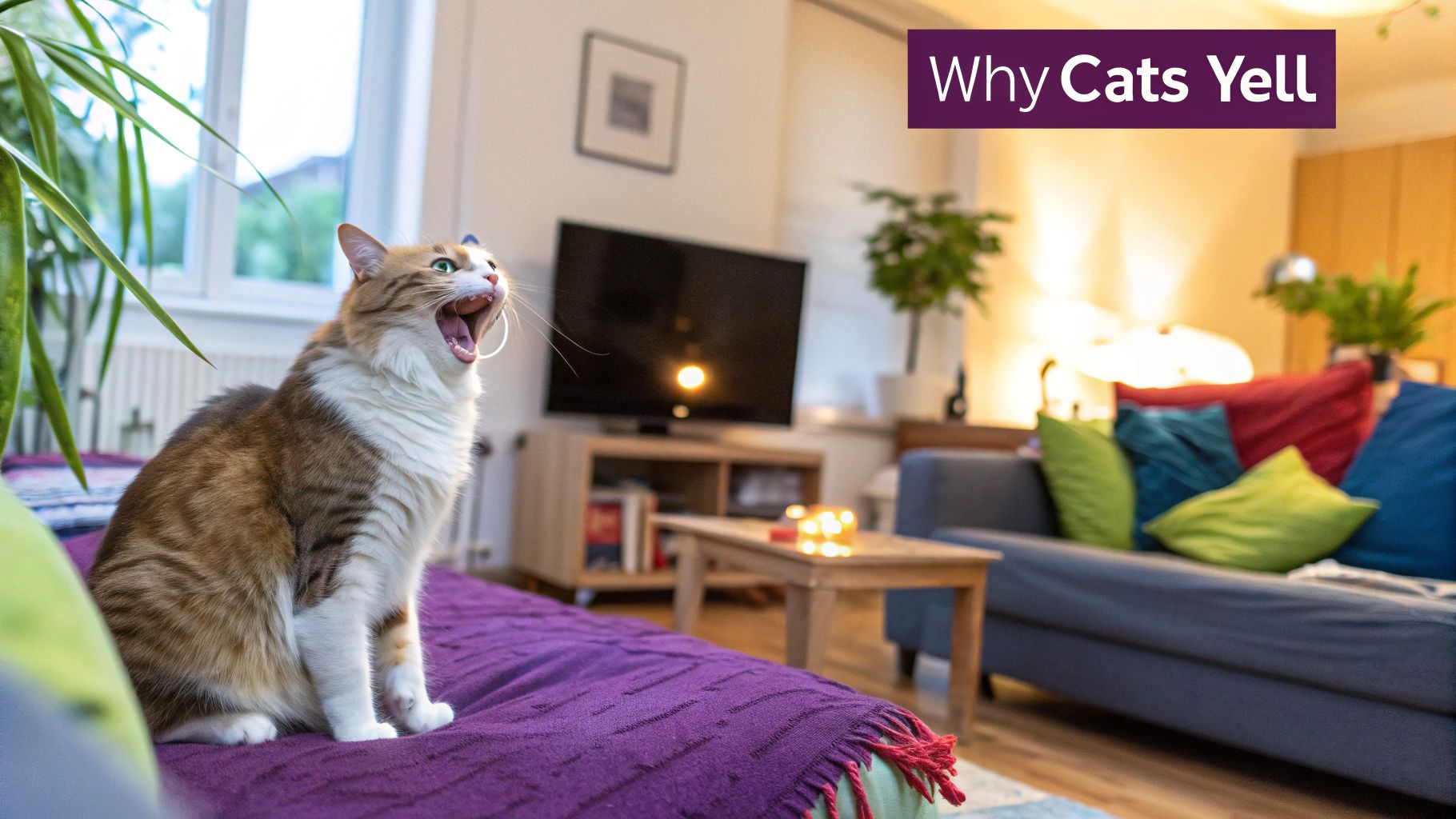
This whole behavior is deeply rooted in how cats evolved alongside us. Our domestic felines have cleverly adapted their communication style to get exactly what they need from their human family. Think about it: feral cats rarely meow at each other as adults, but our house cats use their voices with us constantly, almost like a special language just for humans. It's thought to be a holdover from kittenhood, when mews get their mother's immediate attention. You can discover more insights about cat communication and how they've perfected this unique skill.
And let's be honest, our own habits play a huge part. If you toss your cat a treat or scoop them up for a cuddle every time they let out a demanding yowl, you’ve accidentally taught them that being loud is the fastest way to get what they want. They're smart little cookies! 🍪
How to Manage the "Look at Me" Meows
So, how do you deal with this without encouraging a full-blown opera every single evening? The key is to redirect their energy and meet their needs before the yelling even starts. It’s not about ignoring your cat, but teaching them that quiet, polite behavior gets all the rewards.
A bored cat is almost always a loud cat. Keeping their brain and body engaged is one of the best ways to curb those attention-seeking cries.
- Interactive Play: Set aside at least 15-20 minutes a day for some quality, active playtime. A good wand toy, like our Feather Wand Toy, mimics hunting and helps them burn off all that pent-up energy in a positive way. Get them leaping, pouncing, and chasing!
- Mental Stimulation: Don't forget to exercise their powerful brains! A Floofie Food Puzzle is perfect for this. It challenges them to work for their treats, which stops boredom-induced meowing and gives them some satisfying mental work to do.
- Scheduled Snuggles: If your cat is yelling for affection, try initiating cuddle sessions when they are being quiet. This reinforces the idea that calm behavior is what brings on the pets and scratches they crave.
Remember, the goal is to be proactive, not reactive. By providing plenty of enrichment and scheduled attention on your terms, you satisfy their needs and strengthen your bond, leading to a quieter, happier home for everyone.
Building a predictable routine helps your cat feel secure and understood. They'll start to anticipate playtime and affection, which reduces their need to yell for it. With these Floofie-approved strategies, you can turn down the volume and turn up the purrs. ✨
Decoding the Hidden Language in Cat Yells
Ready to become a feline linguist? To truly figure out "why does my cat yell at me," you have to listen closely. Not every meow is the same, and picking up on the subtle differences is your secret decoder ring.
A short, happy chirp is a completely different message than a long, drawn-out yowl of despair.
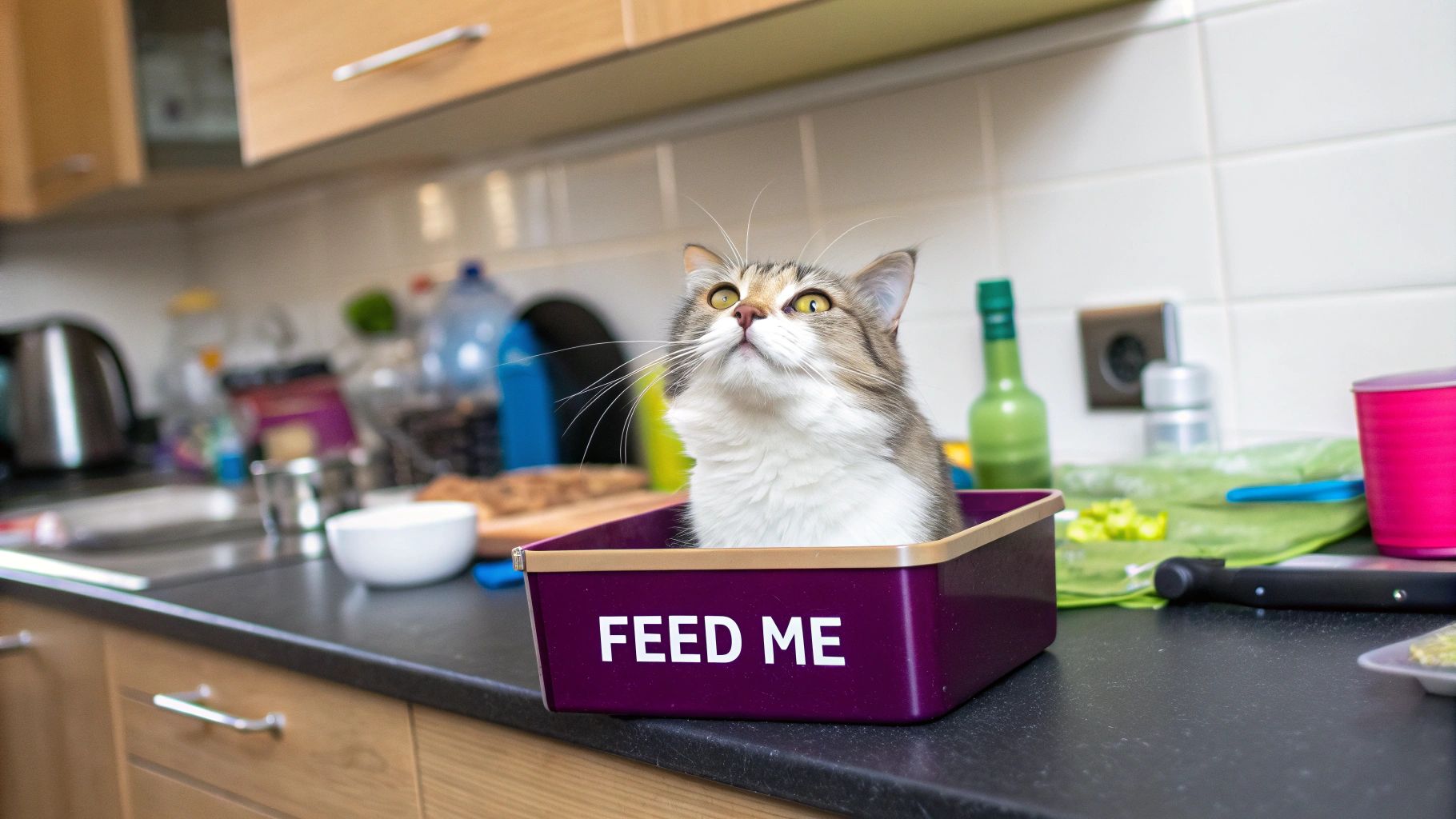
Think of it like this: that high-pitched, quick "mrrp!" when you walk in the door is your cat's way of saying, "Hello! You're home!" 😻 It’s a happy, welcoming sound.
But that low-pitched, rumbling "Mrooooow" that seems to vibrate through the entire house? That’s more like a dramatic, "Alas, my food bowl is a barren wasteland, and I may never eat again!"
This is where paying attention to the context becomes your superpower. If the yelling mostly happens around mealtime, it's a pretty safe bet what your cat is talking about. If it happens when you're busy, it’s likely a call for attention—as Floofie knows all too well.
Listening with Your Eyes Too
But here's the real pro tip: yelling isn't just about the noise. Your cat's entire body is part of the conversation! Learning to read their physical cues along with their vocalizations will give you the full, unedited story of what they're trying to say.
Paying attention to these combined signals is crucial. For example, a purr doesn't always mean your cat is happy—it can also be a self-soothing mechanism when they're in pain. This is why watching their body language is so important.
Here’s what to look for when your cat is yelling:
- Tail Talk: A tail held high with a slight question-mark curve is usually friendly. A twitching, thrashing tail? That's a clear sign of agitation.
- Ear Signals: Ears pointed forward and relaxed are a sign of a content kitty. But "airplane ears," flattened back against their head, scream "I am stressed out!"
- Eye Contact: Slow blinks are the ultimate sign of trust and affection—basically a kitty kiss! Wide, unblinking eyes can signal fear or aggression.
- Body Posture: A relaxed, soft body is a happy body. An arched back with fluffed-up fur means your cat feels threatened. The opposite—a vulnerable tummy-up pose—is a huge sign of trust. If you're curious about this specific behavior, you can learn all about why cats show their belly in our detailed guide.
By combining what you hear with what you see, you move beyond just hearing noise and start truly understanding your cat's language. This holistic view is the key to solving the mystery of their constant yelling.
When Yelling Is a Sign of a Medical Problem
While it's easy to joke about our cats' dramatic dinner demands, sometimes the answer to "why does my cat yell at me?" is a lot more serious. A sudden change in how your cat vocalizes—especially if it’s new, loud, or happens at odd hours—can be their only way of telling you, "Hey, I really don't feel so good!" 🩺
It’s so important to learn the difference between a behavioral meow and a genuine cry for help. Think of it this way: you know your cat's usual chatter. When that familiar tune suddenly changes to a constant, distressed yowl, it's time to pay very close attention.
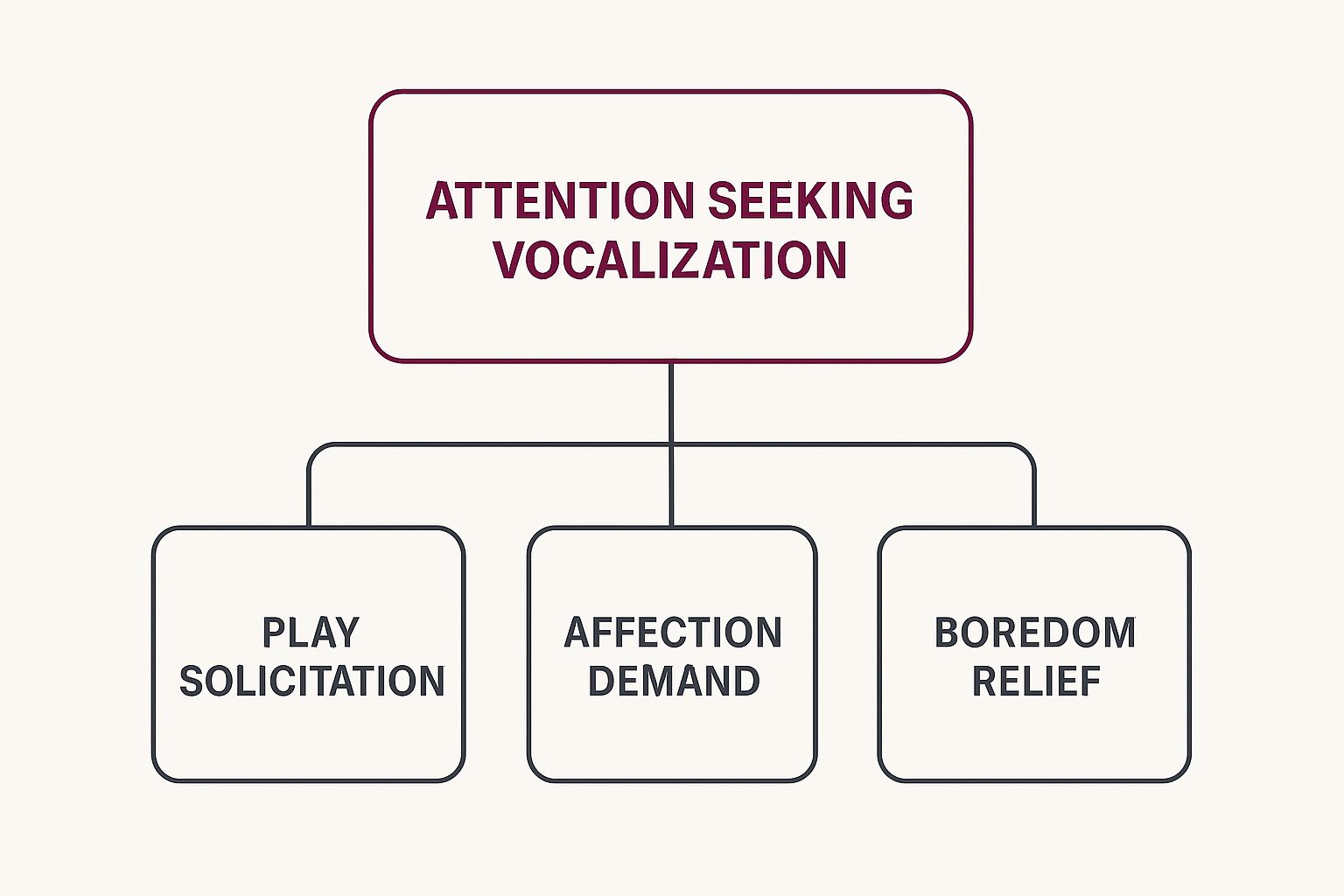
This helps us see that even behavioral yelling has different roots, but medical yelling is in a league of its own and absolutely needs a vet's expertise.
Common Medical Causes for Cat Yelling
Several health issues can cause a normally quiet cat to become painfully vocal. Unlike a simple request for playtime, these meows are often rooted in real discomfort, pain, or confusion. Ignoring them just isn't an option when your fur baby's health is on the line.
Some of the most common culprits include:
- Hyperthyroidism: An overactive thyroid can send your cat’s metabolism into overdrive, making them feel agitated, restless, and ravenous all the time. This often leads to persistent, demanding meows for more food.
- Chronic Pain: Just like us, cats can suffer from conditions like arthritis or dental disease that cause significant pain. Since they're masters at hiding weakness, loud yowling can be one of the few signs that they are hurting badly.
- High Blood Pressure: Hypertension isn't just a human problem. In cats, it can cause disorientation and pain, leading to confused or distressed vocalizations.
- Sensory Loss: Older cats often experience hearing or vision loss as they age. This can be frightening for them, causing them to yell out simply because they feel lost or can't hear their own volume.
A sudden increase in yelling, particularly in a senior cat, should never be dismissed. It's one of the clearest signals they can give that something is wrong and warrants an immediate call to your veterinarian.
Still not sure if that new yowl is a quirky habit or something more? This table can help you spot the difference.
Behavioral Yelling vs. Medical Yelling
| Symptom | Likely Behavioral | Potentially Medical (Consult a Vet!) |
|---|---|---|
| Timing | Yelling happens around specific events (mealtime, you coming home). | Yelling is constant or happens at random, odd hours (like the middle of the night). |
| Sound | Sounds like their "normal" demanding meow, just more frequent. | The sound is different—a distressed, pained, or mournful yowl you haven't heard before. |
| Context | Stops when they get what they want (food, attention, playtime). | Continues even after their needs are met; seems unrelated to their environment. |
| Other Signs | Cat seems otherwise happy and healthy. | Accompanied by other symptoms like weight loss, changes in appetite, litter box issues, or lethargy. |
Ultimately, you know your cat best. If their cries seem out of character and genuinely concerning, trusting your gut and calling the vet is always the right move.
Cognitive Dysfunction in Senior Cats
As our beloved kitties enter their golden years, some may develop Cognitive Dysfunction Syndrome (CDS), which is very similar to dementia in humans. A cat with CDS can become easily disoriented, anxious, and confused, especially after the sun goes down. 🌃
This confusion often leads to loud, mournful yowling that seems to have no direct cause. They might cry because they can't find their way to the litter box, or because they've forgotten where their favorite human is sleeping.
For these sweet seniors, providing extra comfort is key. A supportive bed like our Ortho-Cloud Cat Bed can give their achy joints much-needed relief and create a safe, cozy space that helps reduce their anxiety and confusion.
Environmental Stressors That Cause Yelling
Sometimes, the answer to "why does my cat yell at me?" has less to do with you and a lot more to do with their surroundings. Cats are creatures of habit who find a deep sense of comfort in their daily routine. When their predictable little world gets shaken up, that stress often comes out as loud, anxious meowing. 🙀
Think of your cat as the meticulous manager of their own little kingdom. If you suddenly rearrange all the furniture, bring in a noisy new roommate (like another pet or a baby), or move the entire operation to a new building, you can bet the manager is going to have some loud complaints!
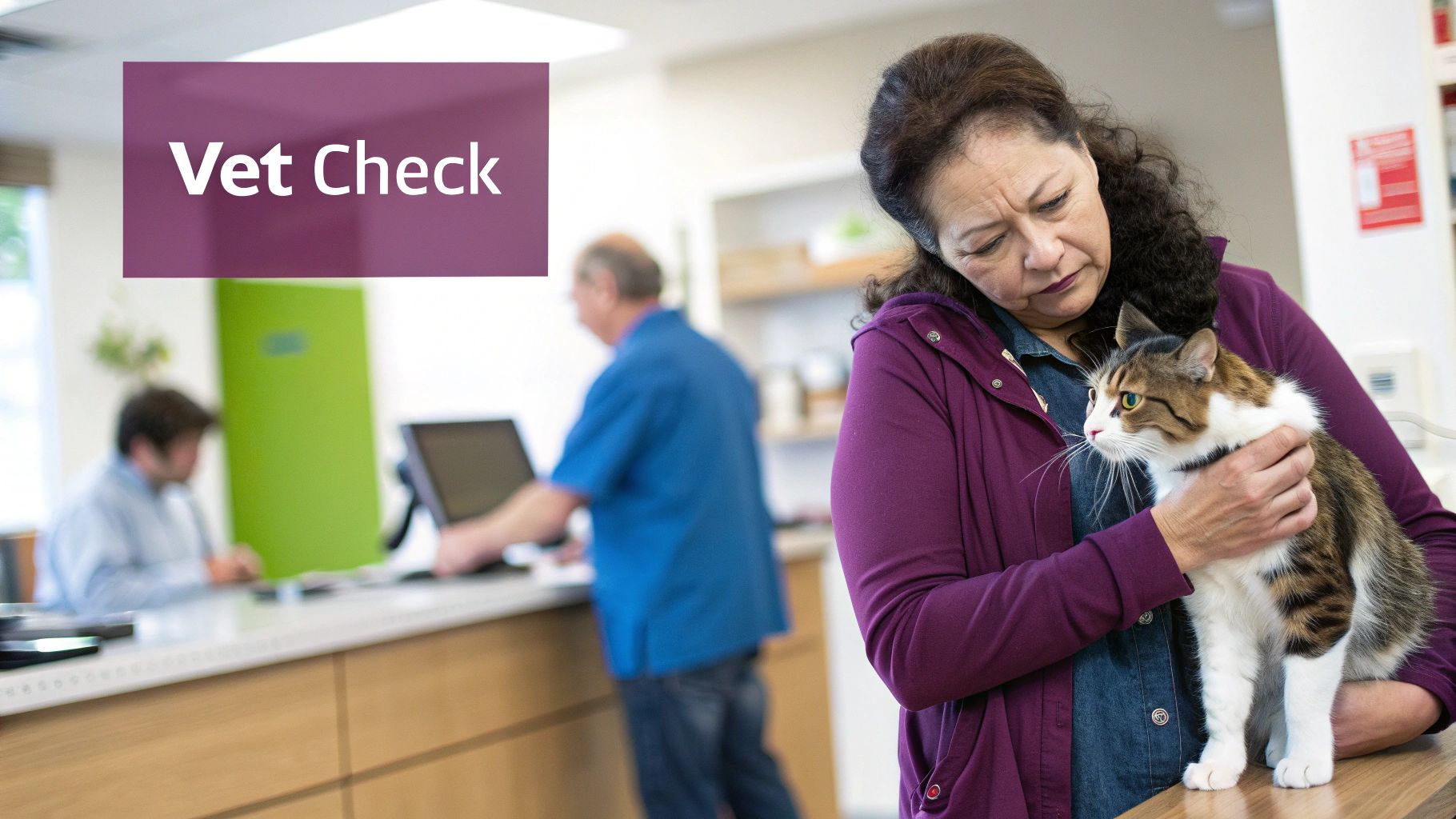
This sensitivity is deeply ingrained in their DNA. The context of your cat's environment can dramatically influence how much they vocalize. In fact, studies show that cats tend to meow the most when isolated in an unfamiliar place—a clear sign of just how much they rely on a stable, secure territory to feel at ease.
Creating a Peaceful Kitty Kingdom
So, how do we help our furry overlords feel more secure and a little less shouty? The key is to create a space that feels safe, predictable, and engaging. A cat's home needs to be their sanctuary, not a source of constant surprises. Even minor disruptions, like a new piece of furniture or unfamiliar guests, can be enough to trigger a chorus of protest yowls.
Your goal is to become the benevolent ruler who restores order and calm. Here are a few ways to build a more peaceful environment for your feline friend:
- Establish a Consistent Schedule: Try to feed them, play with them, and cuddle around the same times each day. This predictability is like a security blanket for cats, helping to reduce anxiety-fueled yelling.
- Provide Vertical Territory: Cats feel much safer when they can survey their domain from up high. A tall, sturdy cat tree gives them a personal perch away from all the household chaos.
- Use Calming Aids: When stress levels are running high, pheromone diffusers can work wonders. They release comforting signals that essentially tell your cat's brain, "Hey, you're safe here."
- Secure Their Favorite Spots: Make sure their food bowls, water, and litter boxes are in quiet, low-traffic areas where they won't be startled. Also, be mindful of new additions like houseplants—check out our guide on how to keep cats out of potted plants to avoid any territorial disputes.
By enriching their environment and respecting their need for routine, you're not just quieting the noise—you're addressing the root cause of their stress, leading to a happier, more peaceful companion.
Taking Action: Your Guide to a Quieter, Happier Cat
Okay, you've done the detective work and have a much better idea of why your cat is staging a one-feline protest in your living room. Now it's time to shift from investigator to coach and put a solid plan into action! ✨
The goal here isn't to silence your cat completely—that's just not how they're wired. Instead, we want to teach them a new way to communicate, showing them that polite, quiet behavior is what truly unlocks all the good stuff: your attention, the tastiest treats, and those coveted play sessions.
Our secret weapon for this is positive reinforcement. In simple terms, this means rewarding the quiet moments and calmly ignoring the demanding howls. It’s tough, we get it! After all, Floofie has trained us well, and tuning out his dramatic "the world is ending, feed me now" opera is a serious test of willpower. But consistency is absolutely everything.
The Proactive Happy Cat Checklist
To really turn down the volume, you have to get ahead of the game. That means meeting your cat's needs before they feel the need to shout about them. A fulfilled, happy cat is almost always a quieter cat. Think of this as your daily mission for achieving peace and purrs.
Start by making this simple checklist a part of your routine:
- Schedule Daily Playtime: Carve out at least 15-20 minutes for some focused, interactive play every single day. A good wand toy is a game-changer here, and our Floofie Feather Wand is perfect for letting them hunt, pounce, and burn off all that pent-up, noisy energy.
- Give Proactive Affection: Don't wait for the meows to start. Make a point of initiating cuddle sessions when your cat is just chilling out, being calm and quiet. This directly teaches them that relaxation—not yelling—is the real key to getting your love and attention.
- Engage Their Brain: A bored cat is often a loud cat. Keep their brilliant minds busy with something like a Floofie Food Puzzle. It turns mealtime into an engaging challenge that satisfies their natural instinct to forage and problem-solve.
By building a predictable routine filled with play, affection, and mental enrichment—all on your terms—you start addressing their needs before they escalate into demands. This one simple shift can transform your home from a concert hall of cat yells into a sanctuary of peaceful purrs.
Remember, you aren't punishing your cat for meowing. You're simply making quiet behavior a much more rewarding and effective way for them to get what they want. It’s a language they'll pick up on faster than you think. Stay strong, be consistent, and get ready for a more harmonious life with your furry best friend. 💖
Frequently Asked Questions About Cat Yelling
Still have some lingering questions about your cat's vocal habits? You're in good company! It's one of the most common mysteries cat parents face. We’ve rounded up some of the top questions we hear and let our expert-in-residence, Floofie, weigh in. 🧐Why Does My Cat Yell At Me In The Morning
Ah, the classic feline alarm clock! ⏰ If your cat gets loud right as the sun comes up, it's almost always a learned behavior. They've figured out that you getting up means breakfast isn't far behind.
They're also genuinely excited to see you after a long night of you just… sleeping. How boring! To break the cycle, try an automatic feeder. This helps your cat associate the machine—not you—with their morning meal. A good, hard play session right before your bedtime can also tucker them out, buying you a few more precious minutes of sleep. Floofie highly recommends a pre-snooze chase with the Floofie Feather Wand to guarantee a quiet morning.
Is My Cat’s Breed Making Them Yell More
It absolutely can! Some cat breeds are just naturally more talkative than others. Siamese cats, for example, are legendary for their chatty nature. They’ll happily give you their opinion on everything, from the squirrel outside to your taste in music. 🗣️
On the other end of the spectrum, breeds like Persians or Ragdolls tend to be much more reserved and quiet. But remember, every cat has their own personality. You can always find a quiet Siamese or a noisy Ragdoll—it’s all part of their individual charm!
My Senior Cat Recently Started Yelling At Night. What Should I Do
A sudden change like this in an older cat is a big red flag, and it means you should schedule a vet visit right away. This can often be a symptom of Cognitive Dysfunction Syndrome (CDS), which is very similar to dementia in humans. The confusion it causes can be distressing for them, leading to loud meows, especially at night.
Nighttime yelling in a senior cat could also be related to hearing or vision loss. They might feel disoriented in the dark. Underlying pain that gets worse when they're trying to settle down is another common culprit. Your vet is the only one who can properly diagnose the issue and suggest ways to help, like adding nightlights to make your kitty feel more secure.
Making sure your senior cat is comfortable can make a world of difference. The Ortho-Cloud Cat Bed is the purrfect supportive spot to help them feel safe and cozy through the night.
At FloofChonk, we're here to help you understand and spoil your furry best friend. From super-soft apparel to fun, engaging toys, we have everything you need to keep your cat happy, healthy, and maybe just a little quieter. Shop the full collection today!
